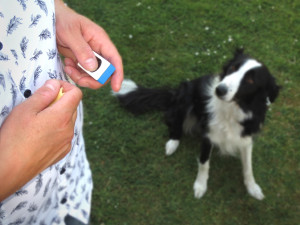Clicker Training Basics.
Clicker training is a great way to teach your dog new things and it’s ideal for dogs of any age. It’s also great fun for people too! If you want to find out about clicker training basics and all you need to get started on this positive way of training dogs – read on!
Clicker training is a great way to teach your dog new things in a non-confrontational and motivational way. It is known as ‘positive reinforcement’ based on operant conditioning – (remember Pavlov and his drooling dogs?). It is an ideal way to teach your dog, or puppy, new skills.
Around the 1950s, this method of animal training was widely used in marine mammal training. However, rather than clickers, whistles were the more common tool. Keller Breland was the first man to use what he described as a ‘cricket’; an audible marker to bridge the gap between the desired behaviour and the reward.
Scientific approach.
Clicker training isn’t a new concept. It has been widely used for many years and it is an approach that many trainers are now using in more sophisticated ways within the field of canine behavioural therapy.

you can even train chickens with a clicker!
The clicker can teach dogs (and other animals, including chickens!) all manner of tricks and behaviours. However, it does not mean that you will always need to carry a clicker and treats.
Once the new behaviour is learnt and you begin to pair it with a particular word, like ‘sit’, you can then fade out the use of the clicker and treats.
The clicker is a clear signal to the dog that a reward is on its way. This might not even be a food reward. It could be a game with a toy, or tactile petting. For best results, however, food is the preferred choice.
Alternatively, you can use a word as your maker, such as ‘Yes!’ However, the benefit of the clicker, over a verbal sound, is that the noise of the click is always consistent, whereas a tone of voice may change.
The clicker.
To get started, you will need a clicker. These are cheaply and readily available in pet retail stores and online. There are lots of different styles and you can even make a home-made clicker.
A lid of a jam jar, for example, the type that ‘clicks’ when you depress the centre. If you think your dog may be startled by the sound of the clicker, (some are louder than others) – muffle the sound by pressing a small piece of ‘blu-tack’ onto the click plate.
Treats.
Next, you will need LOTS of tasty treats. The best treats are ones the dog will regard as high quality. Cooked liver, chicken, or cheese, are all ideal. The pieces need only be very small, no bigger than a quarter of the size of your thumbnail.
There are proprietary treats on the market, but homemade ones are better, principally because you can have a greater quantity. Avoid, hard biscuit treats which cause the dog to become thirsty, are less digestible and take longer to swallow.
Rapid delivery of easily eaten titbits, is the aim. You can place these treats in a bum bag, or nearby (out of reach!) in a container, or dish. Have a few ready in your hand for quick delivery.
‘Charging’ the clicker.
Start your training indoors, somewhere quiet where there are no distractions. To begin, simply click the clicker and reward your dog immediately after. (You are not asking, or looking for any particular behaviour, to begin with). You can give the dog the treat directly to their mouth, or drop it nearby on the floor. Repeat this several times.
When your dog begins to prick up their ears, or looks excited, once they hear the click – you know they have made the association between the marker (click) and the treat. It is important to note that the clicker should not be used like a T.V. remote control 😉 Avoid pointing the device at your dog.

Try and hold your clicker hand out of the way. Keep it tucked neatly into your palm and try not to wave your clicker hand around, as this may be a confusing signal to the dog. Click only once and don’t use the click, click, sound to get your dog’s attention.
The ‘Ah, HA!’ moment.
Finally, you’ll reach the ‘ah HA!’ moment 🙂 Once your dog begins to respond to this and you can see anticipation of the delivery of the treat, you will have effectively ‘charged’ the clicker.
The dog now understands the ‘click’ means a treat is coming. You’re then ready to start training specific behaviours. This is the most exciting point when you begin to use the clicker – you will almost be able to see your dog using their brain!
This can be approached in two ways. You can simply wait for your pup to offer the behaviour you want, such as a sit. Click and treat as soon as bottom hits the floor. This is more time-consuming and relies on the handler being pretty vigilant.
Alternatively, you can lure, or shape the dog into performing the behaviour you want. For example, use a treat and hold it above the dog’s nose and move your hand backwards and over the dog’s head. Usually, the dog will go into a sit. As soon as this happens – i.e. as soon as their bottom touches the floor – click – and reward.
Final thoughts.
Lastly, Clicker training is not only highly effective – it is a fun and kind way to train your dog, or puppy. Clicker training can be applied in all sorts of training situations from basic cues to scent training and more. If you have enjoyed our article on clicker training basics, we have plenty more training tips on our Holidays4Dogs website.




